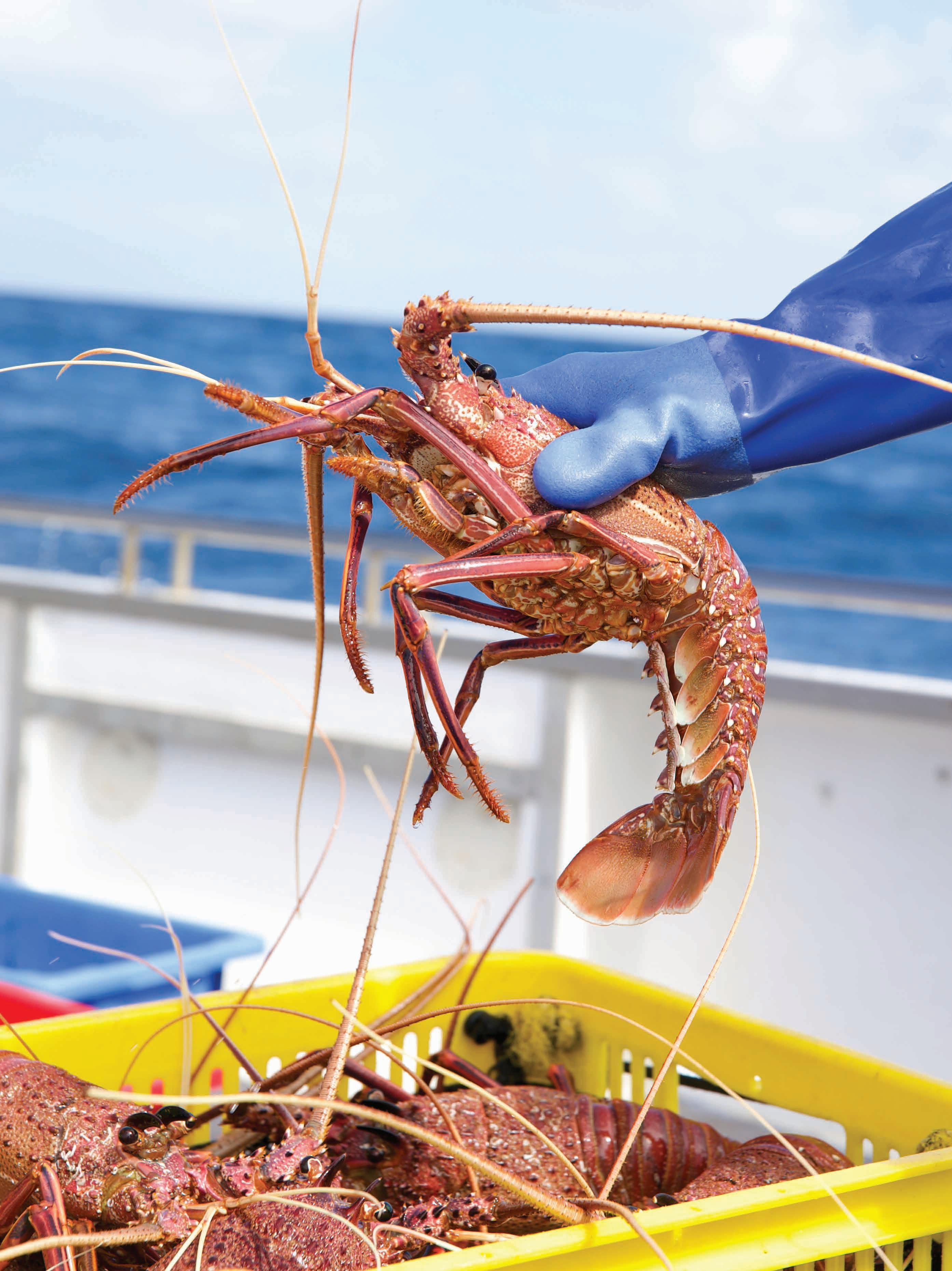lobster tales
Seasonal Lobster Recipes Winter warmers
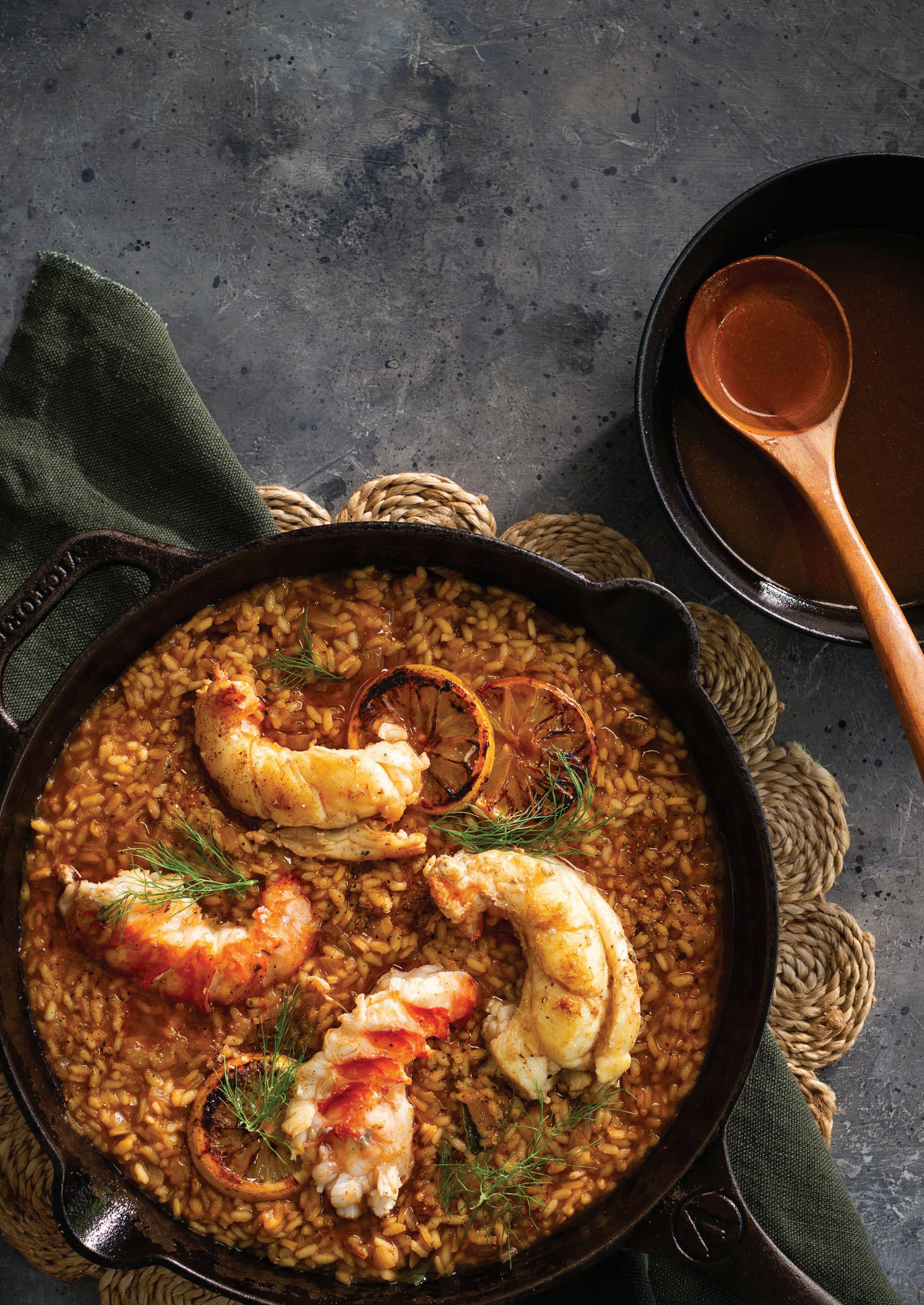
Portraits of industry icons - John Fitzhardinge & Jane Liddon Stories from the boat deck Meet our fishers
Risotto with Brown Butter Lobster
Seasonal Lobster Recipes Winter warmers

Portraits of industry icons - John Fitzhardinge & Jane Liddon Stories from the boat deck Meet our fishers
Risotto with Brown Butter Lobster
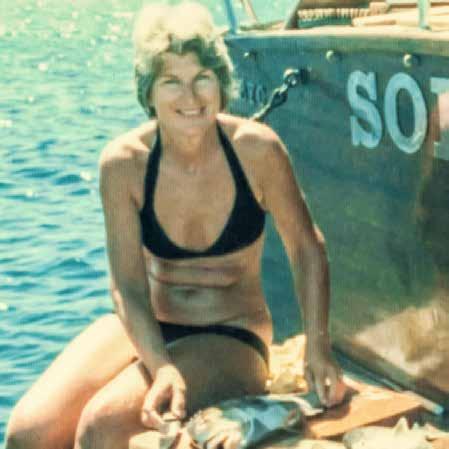



KATE FLOWER
MAGAZINE EDITOR CREATIVE DIRECTOR
West Australian food creative and stylist
Kate Flower loves nothing more than cooking with and talking about local produce. Fremantle-based, Kate keeps all the plates (metaphorical and physical) spinning with a hectic but fun family life, and a busy and creative working life under her banners Kate Flower Food and Flower Food Studio, both focussed on creative services in the food industry. If Kate had to pick a favourite dish from this winter edition of Lobster Tales, it would be the Lobster Toastie because it’s simple, delicious and has a great backstory – and Kate is all about the story!

RECIPE DEVELOPER
Cooking, produce and food has been Alicia’s passion from an early age – her childhood memories catalogued by smell and taste. Lucky to have a family who shares her curiosity and passion for food, her career in food unfolded organically. When she’s not in the kitchen, Alicia can be found with her hands in the soil, tending her family’s extensive orchard and vegetable patch, which aligns with her commitment to flavour, the environment and sourcing locally-grown produce. If Alicia had to pick a favourite dish from this winter edition of Lobster Tales , it would be the Lobster Bisque, simply because of its rich aroma and the memories it evokes.
wine matches our Asian lobster recipes 20-22
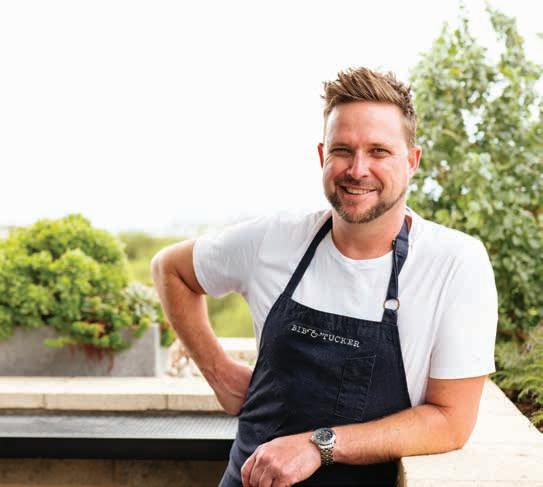

CRAIG KINDER
LEAD PHOTOGRAPHER
A nature man at heart, Craig Kinder is never happier than surfing or taking photos in the natural environment particularly along our coastline. An award-winning photographer, Craig has specialised in food and travel for the past 30 years and has 45 cookbooks to his name. Career highlights include shooting Curtis Stone’s first cookbook in London in 2004, working with renowned French chef Alain Fabregues of The Loose Box and his travels to Vietnam, Sri Lanka and India to photograph different cultures and cusines. As a lover of the ocean and seafood, he was excited to take part in this Western Rock Lobster publication knowing their commitment to sustainable fishing practices.
Features writer: Georgina Barker @georginabarkerphotography

GRAPHIC DESIGNER
Ocean swimmer, beachcomber and surfer, Jill has lived life porous with the West Australian coastline – its sights and sounds the backdrop and soundtrack to her life. Jill’s creativity is inspired by the invigorating natural wonders of our unique WA environment. Her design business, aptly named Sea Pixel, services clients spanning from small business to industry leaders and her most valuable skill lies in balancing eye-catching and entertaining material with commercial practicality to pave the most successful paths for her clients within their marketplace.

This issue delves into the heart of winter, offering you a collection of recipes designed to bring warmth and comfort to your table. From hearty soups to decadent lobster pasta, these dishes showcase the versatility and exquisite taste of our local rock lobster.
One of the highlights of this issue is our chef profile featuring Scott Bridger, who shares his passion for working with western rock lobster and offers insights into his creative process. We also shine a spotlight on lobster fisher turned pearl farmer Jane Liddon, recognising her contributuions to the fishery. And we pay tribute to John Fitzhardinge, a boat designer and former lobster fisherman, whose innovations have helped shape the industry.
Sustainability remains at the forefront of our mission, and we continue to explore the importance of responsible fishing practices and environmental stewardship. Our commitment to sustainability ensures that future generations will continue to enjoy this incredible bounty from our oceans.
We are also excited to introduce you to the Back of Boat website, a valuable resource for lobster novices through

to enthusiasts. This website offers a wealth of information, from sourcing live lobster directly from local fishers in the Back of Boat directory through to handling, preparing and recipes.
In the spirit of community and collaboration, we invite you to explore the pages of Lobster Tales , where every recipe, every story, and every insight is a tribute to the enduring legacy of our coastal traditions. Join us in celebrating the rich heritage of Western Australia’s rock lobster industry by supporting local fishers and sharing in the joy of lobster cuisine, ensuring that this cherished industry thrives for generations to come.

This resourceful recipe maximises every bit of your beautiful western rock lobster, ensuring nothing goes to waste and delivering a delicious rich seafood stock. This bisque is used in the risotto on the page to follow; however, it could also be a showstopping stand-alone dish served with crunchy croutons and herbs.
GF | DF | MAKES: 2L
TIME: 10 mins |
TIME: 4+ hrs
• 2 lobster heads and shells, reserved from cooked lobster
• 4 Tbsp olive oil
• 2 medium onions, diced
• 1 fennel bulb, diced, fronds reserved
• 4 celery stalks, sliced
• 2 carrots, diced
• 2 large tomatoes, diced
• 4 cloves garlic, roughly chopped
• 4 Tbsp tomato paste
• 4 bay leaves
• 1 bunch thyme
• 1 tsp salt
• 1 cup white wine (or replace with water)
• 2.5L water
1. Add all ingredients to a large saucepan or stockpot.
2. Simmer on medium-low for as long as possible, 4 hours plus.
When ready, skim off any froth and strain liquid into a large bowl or saucepan for future use.
• Store, covered, in the fridge for up to 4 days.
• Store left over stock in small portions in the freezer to use at a later time.
• Lobster bisque stock can be a stand-alone dish. Serve it with croutons and fresh herbs for a deliciously rich soup
• Use this base stock recipe to enhance any meal. Replace recipes in this magazine requiring ‘quick lobster stock’ with this delicious stock.
The deep, satisfying flavours of lobster bisque are at the heart of this indulgent lobster risotto. A perfect winter recipe to pleasantly fuss over in a warm kitchen on a cold day.
GF | SERVES: 4-6 | PREP TIME: 10 mins | COOK TIME: 30 mins
• 2 western rock lobster, raw
• 2 Tbsp olive oil
Risotto
• 6 cups lobster bisque stock
• 50g butter, plus extra to finish
• 2 Tbsp olive oil
• 2 onions, finely diced
• 1 fennel bulb, finely diced, fronds reserved
• 2 bay leaves
• 1½ cups arborio rice
• ½ cup finely grated parmesan
• 1 lemon, juice
• 1 lemon, sliced into rounds
• Salt and pepper to taste
Brown Butter
• 50g butter
• salt
Don’t worry if the rice is cooked before adding the entire 6 cups of stock. Only add as much stock as it takes to cook the rice. If risotto thickens before serving, gently stir through additional warm stock.
*Tomalley is the soft, yellow ‘mustard’ found in the head of lobsters.

1. Prepare lobster by removing head and draining *tomalley. Rinse the neck meat gently under running water, removing any tomalley, and pat dry with paper towel. Use heads for lobster bisque stock (page 4). Wrap lobster in cling film to prevent discolouration and refrigerate until ready to cook.
2. Split lobster tails in half lengthways, using scissors to snip through the soft underside then finish with a sharp knife to slice through the flesh and harder outer shell. Remove digestive tract.
3. Heat 2 tablespoons of oil in a fry pan over high heat, add lobster tails to pan, flesh side down and flash-fry for 1 - 2 minutes until golden, flip tail and cook shell side down until lobster is cooked through (4 minutes). Remove lobster meat from shell and set aside.
4. For the risotto, gently heat the lobster stock in a saucepan over medium heat.
5. In a large, wide saucepan, melt the butter and the oil over medium-high heat. Add the onions, fennel and bay leaves and sauté until translucent (4 minutes).
6. Add the rice and stir to coat in butter before seasoning generously with salt and cracked pepper.
7. Add stock to the rice, one cup at a time and simmer, stirring until each cup is almost absorbed. Repeat, allowing each cup to be absorbed before adding the next.
8. Cook, stirring, until the rice is al dente and the mixture is creamy (20 - 25 minutes).
9. Remove bay leaves from rice.
10. Finish risotto with parmesan, lemon juice and zest. Season to taste and stir through additional knob of butter for a creamy texture.
11. Meanwhile, for brown butter lobster, heat butter in a small frypan over medium-high heat. Flash-fry lobster until it turns golden and is heated through (2 minutes). Remove from pan and keep warm.
12. Pan fry lemon slices in the butter until they are caramelised. Cover and set aside.
13. For the brown butter, continue to heat the butter. After a few minutes, the butter will start to foam and begin to turn brown, smelling nutty. Carefully pour the brown butter into a small bowl, leaving any brown specks in the saucepan.
14. Serve risotto immediately, topped with a lobster tail, drizzled in brown butter and a scatter of reserved fennel fronds.
SERVES: 4-6 | PREP TIME: 30 mins | COOK TIME: 20 mins
Cosy up with one of winter’s all time classic dishes. This is no ordinary pasta bake – it’s a super-luxe version, with giant pasta shells holding generous chunks of sweet lobster meat.
• 2 western rock lobster, raw
• Olive oil
• 300g dried conchiglioni (jumbo pasta shells)
Lobster Shell White Sauce
• 600ml milk
• 600ml chicken stock
• 2 bay leaves
• ½ bunch thyme
• Salt and pepper to taste
• 50g butter, diced
• 2 Tbsp olive oil
• 1 onion, finely chopped
• 1 fennel bulb, thinly sliced, fronds reserved
• 2 garlic cloves, finely chopped
• ½ cup plain flour
• ½ tsp salt
• ½ bunch chives, finely sliced
• 1 lemon, juice and zest, plus lemon wedges to serve
• 50g parmesan, finely grated
Crispy Crumb Topping
• 1½ cups panko crumbs
• ¼ cup olive oil
• Pinch cayenne pepper
• ½ bunch thyme, leaves picked
• 50g parmesan, finely grated
To Serve
• Fresh green salad with a vinaigrette
• ½ bunch chives, finely sliced
TO PREPARE
Pre-heat oven to 180°C
1. Cook pasta as per package instructions then drain and drizzle with olive oil to prevent clumping.
2. Prepare lobster by removing head and rinsing the neck meat gently under running water. Set head aside for white sauce.
3. Split lobster tails in half lengthways, using scissors to snip through the soft underside, then finish with a sharp knife to slice through the flesh and harder outer shell. Remove digestive tract.
4. Place a large deep-sided ovenproof frypan over high heat. Drizzle a little olive oil and flash-fry lobster tails, shell side down, for 2 minutes to release the flesh.
5. Remove lobsters from pan, remove flesh from shells and set aside. Reserve shells for white sauce.
White Sauce
6. Place the tail shells and head (optional to rinse *tomalley) in a large saucepan. Cover with milk and stock. Add the bay leaves and thyme, season to taste. Bring to a gentle simmer then turn down heat to medium-low for a minimum

of 20 minutes allowing flavours to infuse. Strain and discard solids before using.
7. Using the same large ovenproof frypan, add butter and oil. Place over medium-low heat and gently caramelise the onion, fennel and garlic (approx 12 minutes).
8. Add the flour to the buttery onions, stirring well to make a creamy paste.
9. Slowly add stock, stirring constantly, until the sauce thickens enough to coat the back of a spoon.
10. Mix through the salt, chives, lemon juice, half of the zest and grated parmesan.
11. Slice each lobster tail into six pieces and stir through sauce. The lobster will continue to cook in the sauce.
12. Fold the cooked pasta through the white sauce and lobster.
13. For the crumb, mix all ingredients in a small bowl with remaining lemon zest and scatter across pasta.
14. Bake pasta until the sauce is hot and crumb golden. (approx 20 minutes).
15. Garnish with fennel fronds and chives.

Replace conchiglioni with any curvy pasta to hold white sauce, such as fusilli or orecchiette.
*Tomalley is the soft, yellow ‘mustard’ found in the head of lobsters. Cook's Notes
Our Back of Boat website isn’t just a direct connection to our community of local fishers; it also answers all your burning questions. Head over to enjoy seasonal recipes, find upcoming event details, read the latest industry information, and discover how our fishers protect the western rock lobster through world-leading sustainable practices. Start exploring!




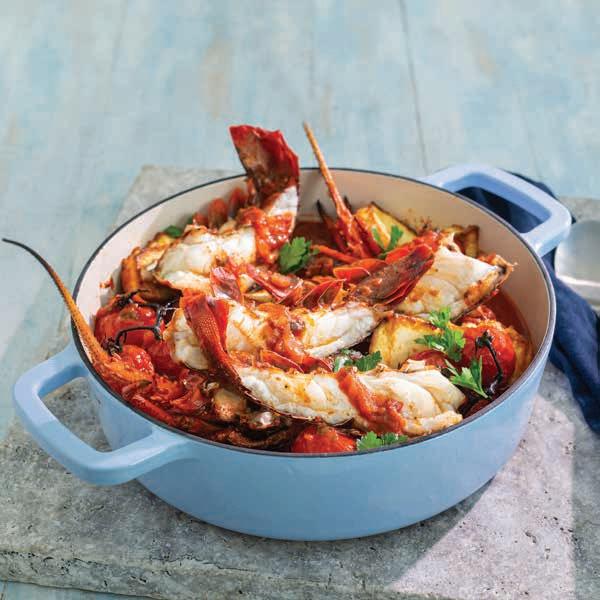

BOILING LOBSTER
1. Fill a large pot two thirds full with salted water (add a tablespoon of salt per litre of water) and bring to a boil.
2. Gently plunge your dispatched lobster/s into the water, head first.
3. Cover, return to a boil, and cook according to the time guide.
4. The meat will change from opaque to white when cooked and the shell will turn bright red.
5. Remove the lobsters from the pot with tongs and place on a plate to drain and cool.
6. If you are serving them cold, plunge them into an ice bath straight away to stop the cooking process.
Remove the head by twisting firmly in opposite direction to the tail. Clean any *tomalley from the neck meat under gently running cold water. Flip the tail upside down so the soft shell is facing up and cut down either side of the ribs so you can peel it back, a bit like opening a can of sardines.
From there, use your hands to loosen the lobster meat from the shell and it should come out easily and neatly. *Tomalley is the soft,
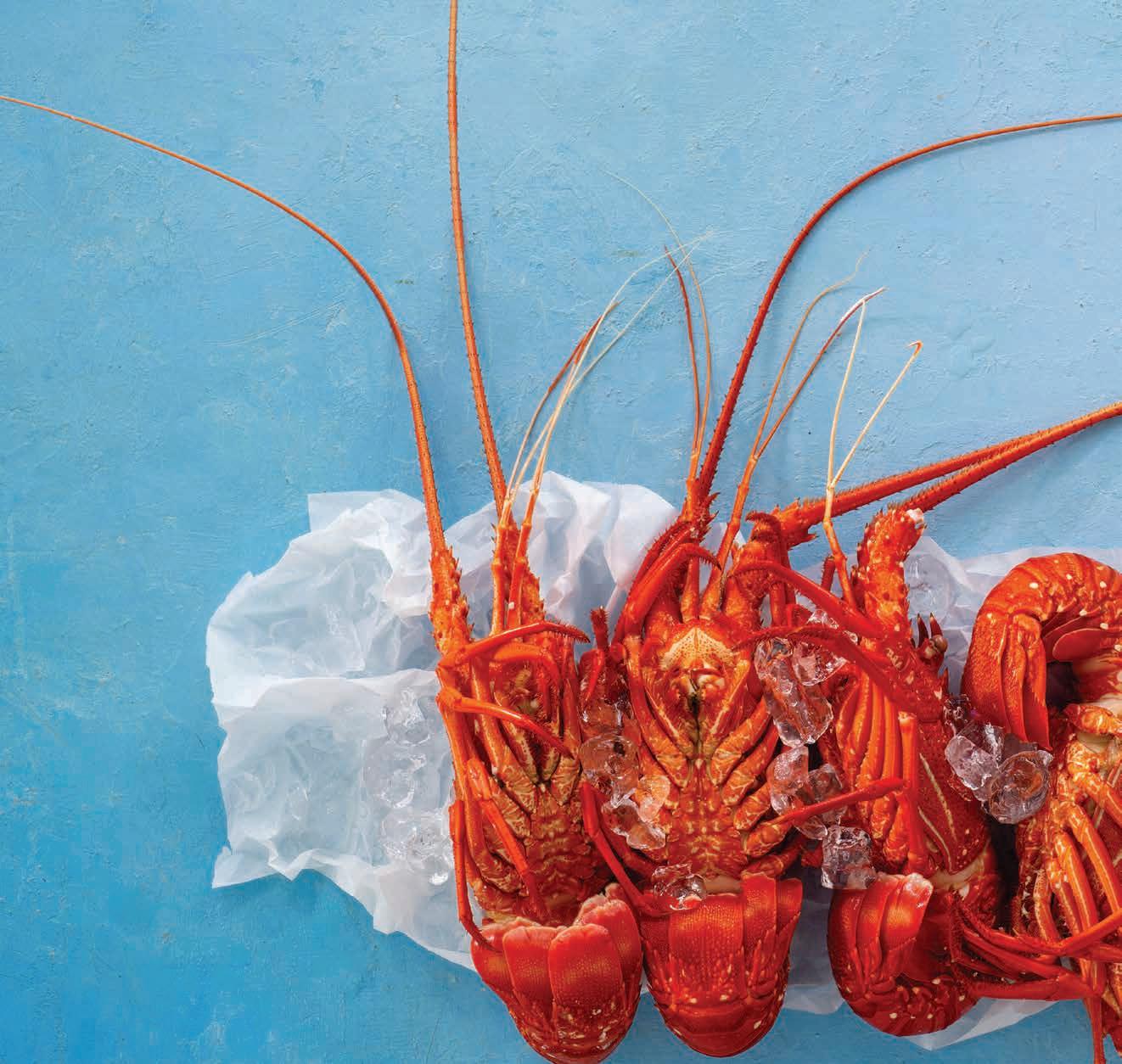

John’s life has been all about the ocean, boats and crays. At 84, it’s a life he continues to love. The morning we interviewed him, he had just returned from pulling his pots off Port Denison, 13 crays in hand for his family and friends to enjoy. His passion for the ocean, boats and crays hasn’t just informed his own lifestyle and career, he’s been a driving force in the boat building and rock lobster industries.

John started in the rock lobster industry when he was 21. Growing up in Claremont, he visited Geraldton for a sailing regatta, decided he’d like to stay, found somewhere to live and landed a job processing crays at Geraldton Fishermen’s Co-operative (GFC). Back then, all the catch was tailed, cleaned and packed into boxes to be frozen and exported to the United States.
Word quickly got out of John’s boat-building experience – he had built his first boat with his father when he was nine –and he was soon designing and building his first commercial vessel, a 25-foot lobster fishing boat for a fisherman in Geraldton. John then jumped on board the fisherman’s previous boat as deckhand for the fisherman’s son and was soon rebuilding this boat as it was not far from falling apart.
By the following season he and his fiancé Beth had built a cray boat Blue Marlin for themselves, “bought a commercial lobster fishing license for 15 quid” and started fishing out of Port Denison. They soon married, went to North Island out at the Abrolhos pretty much on their honeymoon and lived in a tent while building their camp in the afternoons after pulling their pots.
And so started John’s parallel career as a boat designer/ builder and professional lobster fisherman. Operating commercial vessels as a lobster fisherman provided John first-hand knowledge of vessel and equipment operation and maintenance that informed the way he built and equipped the many boats he went on to build.
In 1975 he and Beth established Dongara Marine, which continues today, now with former employee Rohan Warr as partner and a workforce of 80 carrying out all aspects of vessel construction, testing, project management, and business administration.
John went on to establish Geraldton Boat Builders with Mark and Kim Newbold and Terry Bromley, then Strategic Marine, which focused on international shipbuilding, and ultimately Southerly Designs, with Chris Smart as a partner and which still operates out of Port Denison today.
Somehow throughout all this boat designing and building, John found the time to continue fishing, through until he sold out in 2009. It was an exciting and interesting few decades – for the thrill of the catch, the isolated lifestyle, and also for the major changes to the lobster industry.
“The competitiveness of being able to catch as many crays as we could,” reflects John. “And the isolation of living at the Abrolhos Islands for six months of the year – the ‘islands season’. We were on North Island, which is one of the bigger islands. It was a great lifestyle when we were younger. And then when we had kids, we built a school, which had up to 20 kids at times. We were very lucky to have great teachers.”
Not long after John started fishing, licenses were frozen. Then the number of pots were limited, allocated according to boat size. “Another fundamental change was the introduction of multiple escape gaps in the pots for undersize crays to escape,” says John. “We also developed small deck tanks with running seawater from the deck hose to keep the catch in better condition.”

John also talks about the marketing of western rock lobster while he was a director of GFC. “We developed new markets, first for whole boiled frozen lobsters to Japan, then Taiwan, and in the late 1980s live lobsters flown to Japan, then Taiwan and China.”
Through the 70s to 90s he was on the Governmentappointed Rock Lobster Advisory Committee, which was made up of fishermen, processors and scientists who advised the minister on the industry. “We had to make many decisions as we reduced the catching effort to protect the resource, which was both by shortening the season and reducing the number of pots allowed to be worked. The latter started wars!”
It’s 15 years since John sold his lobster fishing license, but his passion and contribution to the industry continues. Just last year, he designed a new panoramic underwater camera system for a Fisheries Research and Development Corporation research project.
And how does John like to eat his crays?
“I boil them just before we eat them, leaving them still a little raw in the middle and eat them plain. I also make big pots of pickled cray with cider vinegar, white wine and herbs.”
We love a recipe with history and soul, and this one is brimming with both, along with generous amounts of western rock lobster! At the heart of this dish is a bechamel recipe handed down to keen fisherman Johnno Wroth by his now 97-year-old grandmother Beverley, who for decades created it to taste using crays caught at Rottnest where she lived on a boat for six months of the year. Johnno spent much of his childhood at Rotto and fondly remembers devouring his grandma’s delicious lobster mornay on the back of the boat – baked then served in a casserole dish with extra cheese on top and breadcrumbs to create the crust, often with oven-baked buttered toast on the side.
SERVES: 4 | PREP TIME: 30 mins | COOK TIME: 10 mins
INGREDIENTS
• 2 western rock lobster, boiled and cooled (see method on page 8)
Bechamel
• 40g butter
• 1 clove garlic, minced
• 40g flour
• 200ml milk, warmed
• 20g Dijon mustard
• ½ tsp paprika, sweet
• 20ml dry sherry or brandy
• 1 lobster *tomalley or more to taste
• Salt to taste
Sandwich
• 2 spring onions, finely sliced
• 1 loaf of good sourdough, sliced into 2cm thick slices
• 80g butter, room temp
To Serve
• Salt and vinegar crisps

TO PREPARE
1. Remove cooked lobster from the shell. Rinse the neck meat gently under running water, dice meat into bite-size pieces and refrigerate until required.
2. Using a teaspoon, scoop out the tomalley from the head of each lobster and set aside.
Bechamel
3. Melt butter in medium saucepan along with the minced garlic.
4. Add flour and cook, stirring until mixture bubbles and thickens.
5. Gradually add warm milk, stirring constantly until mixture boils and thickens.
6. Season the sauce with the remaining ingredients, taste and adjust as required. Allow to cool.
7. Mix the chopped lobster and spring onion through the cooled bechamel.
8. Refrigerate if not using straight away.
Toasted Sandwich
9. Butter each slice of bread on one side.
The bechamel in this recipe will be much thicker than a standard bechamel to hold the lobster together in the sandwich.
If using a sandwich press, try not to squash filling out the sides, lower the lid gently.
*Tomalley is the soft, yellow ‘mustard’ found in the head of lobsters.
10. Lay out four bread slices buttered side down.
11. Spread the lobster bechamel evenly across the sandwiches then close with the second piece of bread, butter on the outside.
12. Heat a sandwich press or heavybased pan and add sandwiches two or four at a time depending on your pan / sandwich press size.
13. Cook until both sides are browned and the bechamel starts to bubble out the side.
14. Serve immediately with a side of crisps or leafy greens.
Quick and easy, these fritters are perfect for a family dinner and equally appropriate for relaxed entertaining.
SERVES: 4-6 | PREP TIME: 10 mins | COOK TIME: 15 mins
2 western rock lobster
Quick Pickled Onion
• 1 tsp boiling water
• ½ tsp caster sugar
• 3 Tbsp white vinegar
• 1 red onion, sliced very thinly
Lobster and Pea Fritters
• 150g plain flour
• 1½ tsp baking powder
• ¼ tsp salt
• Pinch cayenne pepper
• Zest 1 lemon
• 2 spring onions, sliced, plus extra to serve
• ½ cup mint, leaves picked and (pluschopped extra to serve)
• 1½ cups peas, blanched in boiling water
• ½ cup milk
TO PREPARE

• 3 eggs
• 4 Tbsp olive oil
• 1 Tbsp butter
Smoky Mayo
• 1 cup mayonnaise
• ½ tsp smoked paprika
• Pinch cayenne pepper
• 2 tsp lemon juice
To Serve
• Avocado
• Lemon wedges
In a bowl, dissolve sugar in boiling water then add vinegar and onions, pushing them below the liquid to pickle for 15 - 20 minutes.
1. Boil and shell lobster (see recipe page 8)
Lobster and Pea Fritters
2. In a large bowl, stir together plain flour, baking powder, salt and cayenne pepper.
3. Add zest, spring onions and mint. Toss to coat in flour.
4. Stir half the peas through the flour then mash the other half in a separate bowl with a fork.
5. In another bowl, whisk together eggs and milk then stir through mashed peas.
6. Pour egg mixture into flour and fold through to make a thick batter.
7. Dice lobster tails into bite-sized pieces, and stir through batter.
8. Heat small amounts of olive oil and butter in a large non-stick frypan over medium-high heat. Add batter to the pan in one third of a cup measures, pressing down to flatten slightly. Fry for 2 - 3 minutes or until golden on both sides. Drain on paper towel and keep warm.
9. For smoky mayo, combine all ingredients in a small bowl and stir well.
10. Serve lobster fritters with pickled red onion, avocado slices, lemon wedges and smoky mayo.
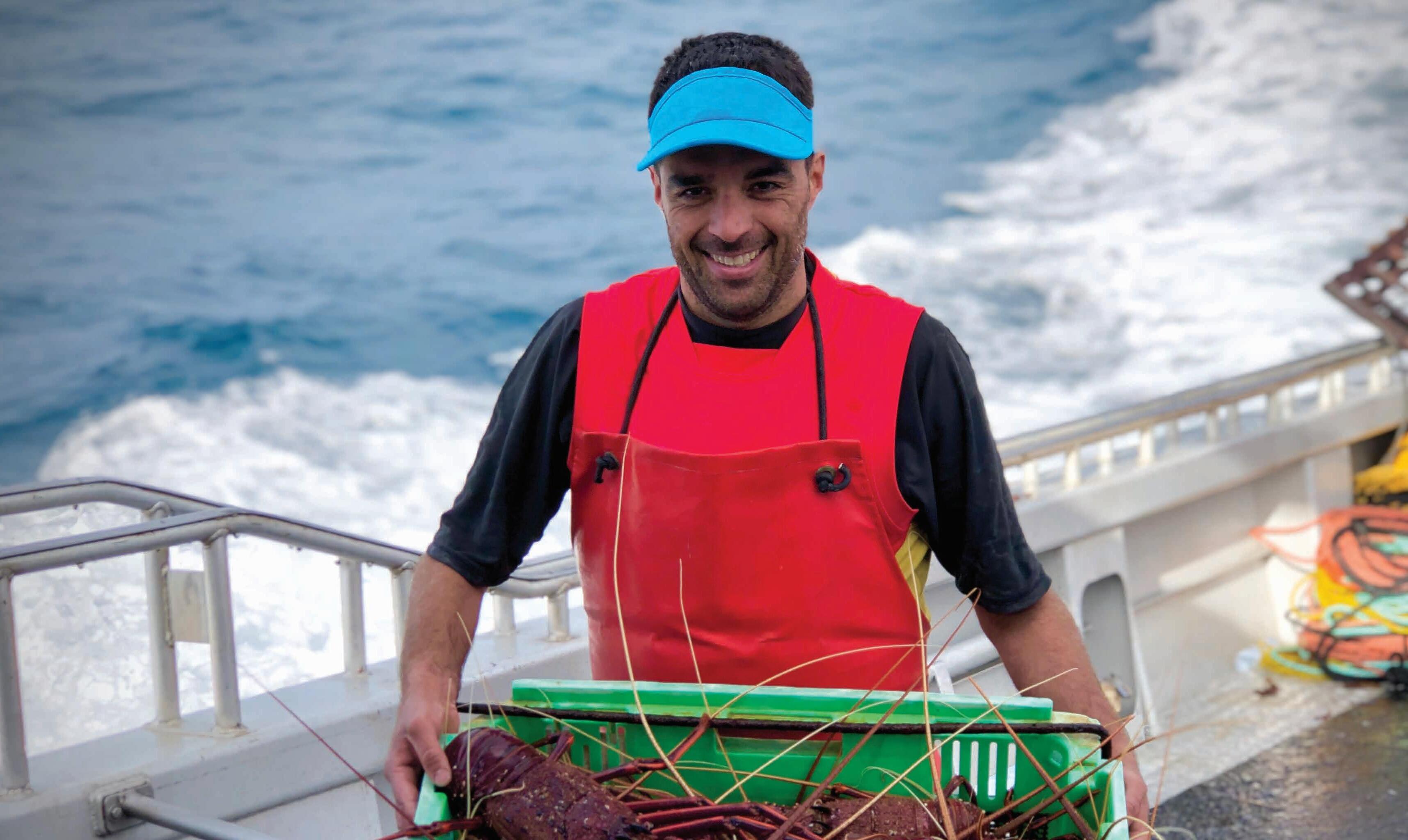
Western Australia’s western rock lobster industry has been implementing world-leading sustainability practices for many decades. In 2000, the fishery became the first in the world to be awarded Marine Stewardship Council (MSC) certification – which sets the international benchmark for ecologically-sustainable fishing.
Western rock lobster expert researcher Dr. Simon de Lestang credits the resilience and management of this fishery to some of the pioneers of the industry who set up processes that are still in place today. The strong relationship between industry and government ensures they work together to maximise social benefits, economic returns, and environmental sustainability for generations to come. According to Western Rock Lobster Council CEO Matt Taylor, sustainability efforts expand on a triple bottom line approach, emphasising environment, economy, society, and governance - a testament to the industry’s progressive sustainability approach.
Pioneers and the puerulus settlement index
One of the best examples of the revolutionary science that was done on the western rock lobster fishery is the puerulus settlement index. In the 1960s, CSIRO scientist Dr. Bruce Phillips worked out that if he put artificial seaweed in the water, he could then shake the seaweed to see how many baby lobsters (puerulus) had settled on it. Incredibly, this puerulus number accurately predicted the lobster catch that would be landed four years in the future when the puerulus had grown into legal size.
Season implemented (15 Nov - 15 Aug)
# fishers limited (no new entrants)
Egg-bearing females protected
Based on this discovery and a desire to know how many lobsters were actually settling in the whole fishery, in 1968 a long-term monitoring program was established by CSIRO, then later expanded by Fisheries WA, to estimate the abundance of young lobsters settling on reefs along the west coast. Puerulus collectors, designed to mimic floating seaweed, were deployed at sampling sites to attract the settling lobsters. A settlement index was calculated for each site based on the number of puerulus retrieved from the collectors each month.
“We still use the same protocols as those developed in the 1960s – and we’ve added more sampling sites so we now cover eight locations between Kalbarri and Cape Mentelle,” says Simon, principal research scientist, lobster and crab, Department of Primary Industries and Regional Development (DPIRD). “We have a consistent data set since that day and it’s one of the best data indices anywhere in the world.”
Fisheries all over the world have tried to replicate the western rock lobster puerulus settlement index, with varying levels of success. Simon is regularly asked to advise other fisheries all around the globe on how to develop a similar index that they can use in the management of their specific species.
1 escape gap required on all pots Size of escape gap increased Limitations on pot design implemented Season shortened (15 Nov to 30 Jun) Maximum pot
10% reduction in # of pots allowed to be used
A good example on the value of this index is what happened in 2008. “In that year we shook the collectors and found pretty much no babies,” says Simon. “This told us that in four years (2012) there would be very few new lobsters moulting into legal size and being able to be caught. And that’s exactly what happened. But because of the warning, we were able to completely change the management system and the number of lobsters that were caught in the years leading up to 2012. We halved it – from 11 million kilos to 5.5 million kilos. We were pretty much banking the lobster for a rainy day.”
Matt Taylor says the transition to a quota system, which involved reducing the commercial catch level to around half of the 10-year average, was a significant challenge for the industry. “While this decision was tough for fishers, it was deemed crucial for the long-term sustainability of the fishery, ensuring that lobsters would be available for future generations,” says Matt. “This transition was not without its difficulties, and the industry’s decision to implement these changes meant that many family businesses were no longer viable, resulting in their departure from the industry.”
Increasing biomass
Ultimately, this decision led to an increase in the lobster population. By reducing the commercial catch from 11 million to 5.5 million kilograms and only gradually increasing it over 13 years to 7.3 million kilograms, the population and catch rates improved significantly. Previously, fishers would average 1 kilogram of lobsters per pot lift annually; now, they average 4 kilograms per pot lift. Consequently, the number of pot lifts needed to catch the quota has decreased dramatically, from 11-12 million pot lifts per year to just 2.2 million pot lifts per year.
The flow on
These changes have had an incredibly positive flow-on effect for the environment and recreational fishers. The commercial fishery’s bait usage has dramatically decreased, from around 10,000 tonnes in the past to about 2,200 tonnes last year. This significant reduction in bait usage has lessened the environmental impact. With fewer pots in the water, there are fewer instances of pots getting snapped off, less plastic being used, and fewer broken floats. The reduced number of pot lifts has also led to a decrease in the number of fishing days, significantly cutting down fuel usage and improving safety by avoiding bad weather. All these benefits stem from better stock management and increased fishing efficiency.
“Another significant advantage of the larger lobster population is the increased catch rates and enjoyment for recreational fishers,” says Simon. “With more lobsters available, anyone with a pot or dive gear can now catch a lobster more easily. It has become a very popular hobby, with more than 50,000 amateurs taking out a license each year.”
Co-management
Unlike many fisheries worldwide, the western rock lobster fishery boasts a strong relationship between the industry group and the government, with Simon describing it as the closest thing to co-management. “It can and has been pretty adversarial between fishers and their government
1990s
Animal hide banned as bait
Further reductions on pot usage and fishing days, plus shorter fishing season


regulator in the past. The two groups sometimes have different drivers. But if two groups can have the same view on what sustainability is and have the same target, they can work well together. In the case of rock lobster, both industry and the government have come to agree on how the resource should be managed because we have the same drivers – that we all want to maximise the economic return from this fishery for everyone.”
Successful co-management is achieved through the involvement of DPIRD representatives in Western Rock Lobster Council’s industry committees and meetings. “DPIRD also participates in all WRL-hosted industry forums and coastal tours,” says Matt. “Industry and government working together ensures all stakeholder perspectives are considered in determining how best to manage the resource now and into the future.”
When fishers were catching large quantities of lobster, market prices were lower. The lobster market is quite unique, with demand fluctuating throughout the year due to festivals, holidays, and wedding seasons. The demand for specific sizes of lobsters also varies for different purposes and can change daily. With a larger lobster population, fishers can choose to fish when demand is high and target the specific sizes most wanted. This allows them to catch fewer lobsters with fewer pots and bait, while maximising their return from this limited resource. This behaviour further increases lobster biomass, ensuring the fishery remains sustainable.
The industry has evolved to target market demand, which serves all stakeholders effectively. This approach includes a triple bottom line assessment that considers sustainability, economics, and ecological aspects. Previously, the goal was to maximise sustainable yield, taking as much yield as the resource could sustain. However, this was risky, as any significant change in environmental conditions could quickly lead to resource depletion.
Now, the focus is on maximising economic yield, which considers the cost to fish and supply and demand relationships in the market, resulting in a lower level of exploitation. Additionally, the management aims to improve ecological impacts while achieving other goals. Maintaining catches at the lower edge of the current range has added benefits such as reduced bait usage, carbon emissions, and time spent fishing, while also increasing recreational catches and their enjoyment.
Quota introduced and catch set at 5.5 million kg (50% of historic average) Fishing allowed year round Intro of recreational catch limits Intro of whale mitigation measures to pots
Gradual increase in catch quotas (now 70% of historic average)


We head south, all the way to New Orleans, to share a creole classic which showcases the versatility of our western rock lobster. This gumbo serves up some serious soul food and is nothing less than comfort in a bowl.
• 2 western rock lobster, raw
Lobster and Fish Stock
• Heads from 2 western rock lobster (see above)
• 1 fish head
Gumbo
• 175ml vegetable oil
• 1 cup plain flour
• 3 brown onions, finely diced
• 4 large celery stalks, diced
• 1 green capsicum, diced
• 6 garlic cloves, coarsely chopped
• 300g Andouille sausage or chorizo, sliced
• 2 dried bay leaves
• 3 tsp Worcestershire sauce
• ½ tsp cayenne pepper, or to taste
• 600g firm white fish, cut into 3cm pieces
• 3 spring onions, sliced, plus extra to serve
• ½ cup flat-leaf parsley, leaves picked and coarsely chopped, plus extra to serve
To Serve
• 2-3 cups steamed medium-grain white rice
• Smoked paprika
• 2 limes, quartered
TO PREPARE
Lobster and Fish Stock
1. Prepare lobster by removing head and rinse out remaining *tomalley. Rinse the neck meat gently under running water, removing any tomalley, and pat dry with paper towel.
2. Cover meat tightly with cling film to prevent discolouration and refrigerate until needed.
3. Bring 2.5 litres of water to the boil in a stockpot, add lobster heads and fish heads. Reduce heat to low and simmer until reduced by half (2 - 3 hours). Strain, discarding solids and set aside.
4. For the roux, heat vegetable oil over low-medium heat in a large casserole or heavy-based saucepan. Add flour and stir frequently with a wooden spoon until mixture starts to deepen in colour (15 - 20 minutes).
5. Reduce heat to very low and stir continuously until roux is dark brown in colour and smells nutty (an additional 10 - 15 minutes; be careful, the mixture can quickly burn if left unattended).
6. Add onions, celery, capsicum, garlic, sausage and bay leaves. Stir occasionally until vegetables start to soften (10 minutes).
7. Gradually add the lobster stock, stirring continuously to create a thick soup. Add enough stock for your desired consistency.
8. Season to taste with Worcestershire, cayenne and sea salt flakes.
9. Meanwhile, prepare lobster tails by splitting lobsters in half lengthways, using scissors to snip through the soft underside then finishing with a sharp knife to slice through the flesh and harder outer shell. Remove the digestive tract.
10. Heat 1 tablespoon of oil in a fry pan over high heat, add lobster tails to pan, flesh side down and flash-fry for 1 - 2 minutes until golden but only partially cooked through. Remove from pan and chop each half into three pieces.
11. Increase gumbo heat to a slow simmer, add lobster and fish pieces and cook until fish is opaque (2 - 3 minutes).
12. Remove pan from heat, add spring onions and parsley then finish with a sprinkle of paprika and serve with steamed rice.
*Tomalley is the soft, yellow ‘mustard’ found in the head of lobsters.
GF option - replace plain flour with gluten free flour
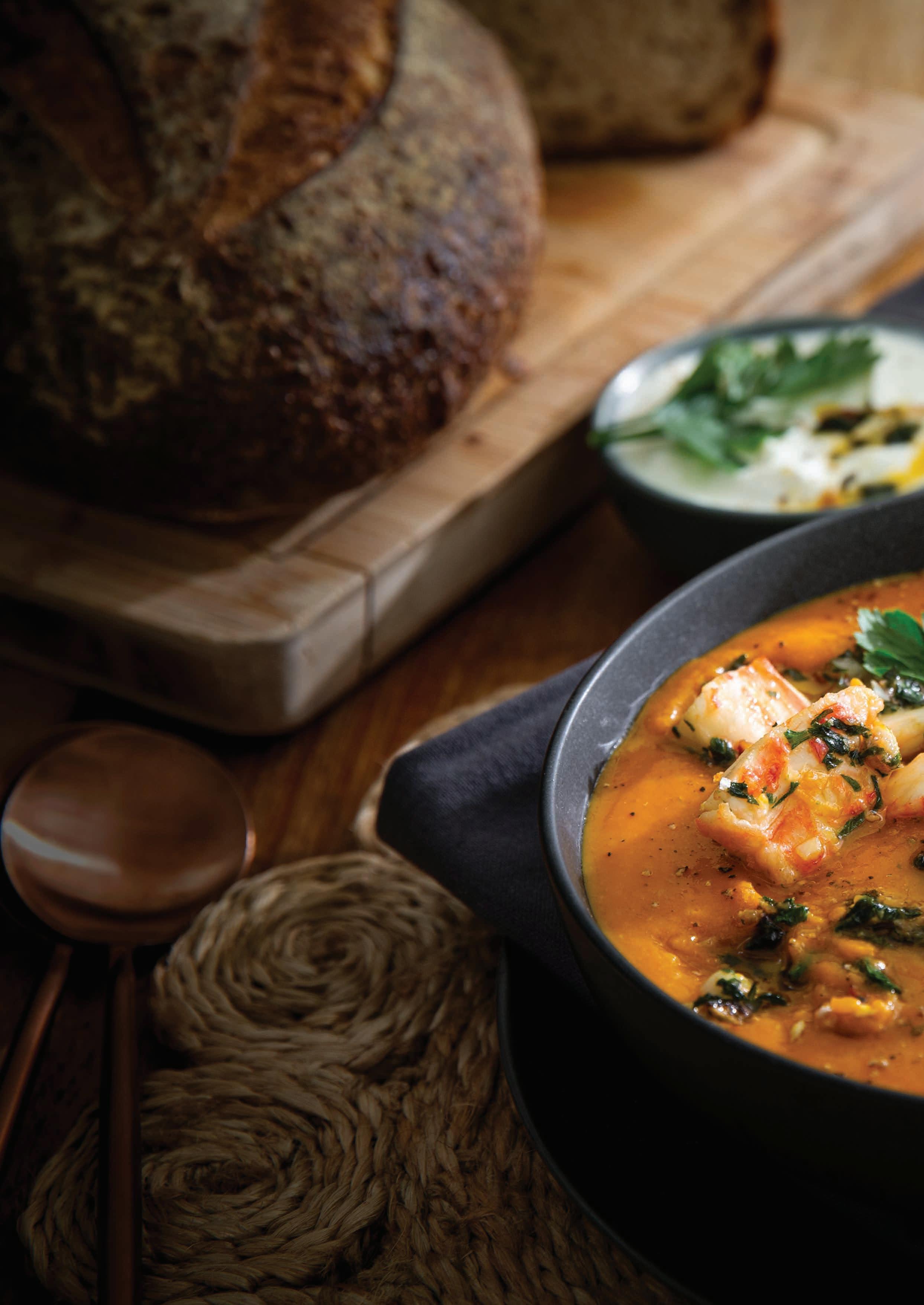
INGREDIENTS
• 2 western rock lobster, boiled
Quick Lobster Stock
• Heads and shells from 2 western rock lobster (as above)
• 500ml chicken stock, store bought
Roast Pumpkin Soup
• 1.5kg Japanese pumpkin, skin on, sliced into wedges, 3cm thick
• 2 onions, peeled and quartered
• 75g fresh ginger, peeled, sliced 3mm thick
• 1 green apple, quartered and cored
• 6 large garlic cloves, crushed and peeled
• 3 Tbsp olive oil
• ¾ tsp salt
• Black pepper
Garlic Parsely Lobster
• 2 lobster tails, reserved from above
• 3 Tbsp butter
• 1 tsp olive oil
• 3 garlic cloves, minced
• ½ cup parsley, leaves picked and coarsely chopped
To Serve
• Sour cream
• Crusty bread
TO PREPARE
Pre-heat oven to 180°C
Quick Lobster Stock
1. Remove lobster from shell, reserving head and shell for stock. Rinse the neck meat gently under running water, removing any *tomalley and pat dry with paper towel. Dice meat into bite-sized pieces and refrigerate until required.
2. In a large saucepan or stock pot, place lobster shells and heads (rinsing tomalley if you prefer) and pour stock over. Cover and gently heat to a low simmer for 40 minutes to impart lobster flavours. When ready to use, strain and discard solids.
Pumpkin Soup
3. Meanwhile, place pumpkin, onion, ginger, apple and garlic into a large roasting pan. Toss with olive oil, salt and pepper.
4. Roast vegetables for 40 minutes, or until pumpkin is soft. Remove from oven and allow to cool enough to handle (10 minutes).
5. Using a large spoon, scoop out pumpkin flesh from skin and place into a deep bowl or the bowl of a food processor.
6. Transfer onions, ginger, apple and garlic to the bowl.
7. Add 1 cup of lobster stock to the vegetables and using a hand-held blender or food processor, whizz vegetables until smooth.
8. Adjust the consistency of the soup to taste with additional stock.
Garlic Lobster
9. Melt butter in a frypan over medium-high heat, add garlic, lobster, parsley and season with salt. Cook for 2 minutes or until the garlic is fragrant and the lobster is caramelised.
To Serve
10. Ladle soup into bowls, add a dollop of sour cream and top with garlic lobster pieces and a drizzle of the warm parsley butter.
There’s nothing more comforting than a hearty bowl of pumpkin soup, especially with the warming addition of fresh ginger. Here we’ve added pan-fried garlic western rock lobster, which takes this family favourite from humble to hero.

Quick lobster stock can be made in advance and will keep in the fridge for three days.
*Tomalley is the soft, yellow ‘mustard’ found in the head of lobsters.
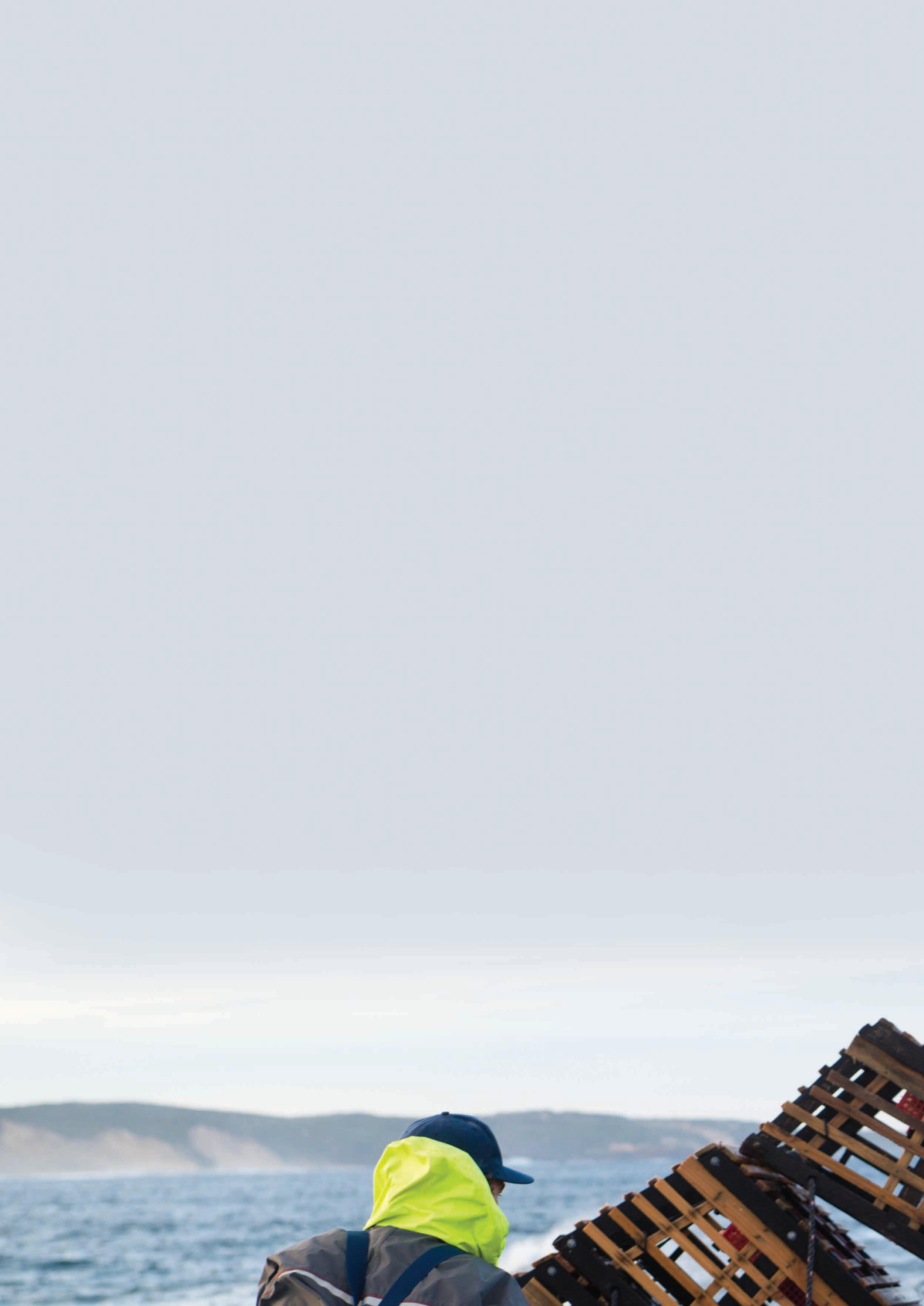

Born and bred into the western rock lobster industry, Clay Bass is a thirdgeneration fisherman. On the boat with his father from a very young age, he remembers being violently ill on Christmas Eve one trip when he was about 10 – not your average childhood Christmas memory, but not enough to put him off fishing. After being on deck for many weekends and school holidays, Clay has now been fishing full time for 26 years, based out of Port Denison and holding quota across all three fishing zones.
What’s the appeal of working on boats as a lobster fisher?
Clay - The appeal for me is around the unknown of what the day is going to bring. It’s always a good feeling to get a better catch than you expected.
Mat - It’s in my blood. I watched dad come in from fishing every day and it was something I always wanted to do. I had a break for a few years and tried other things, but I came back to fishing. Every morning I get to see the sunrise. It’s never the same. I think that’s one of my favourite things. Also, the thrill of the chase. There’s nothing better than putting the effort in, setting pots and then getting rewarded for your effort the next day. Nothing beats that feeling when you get it right.
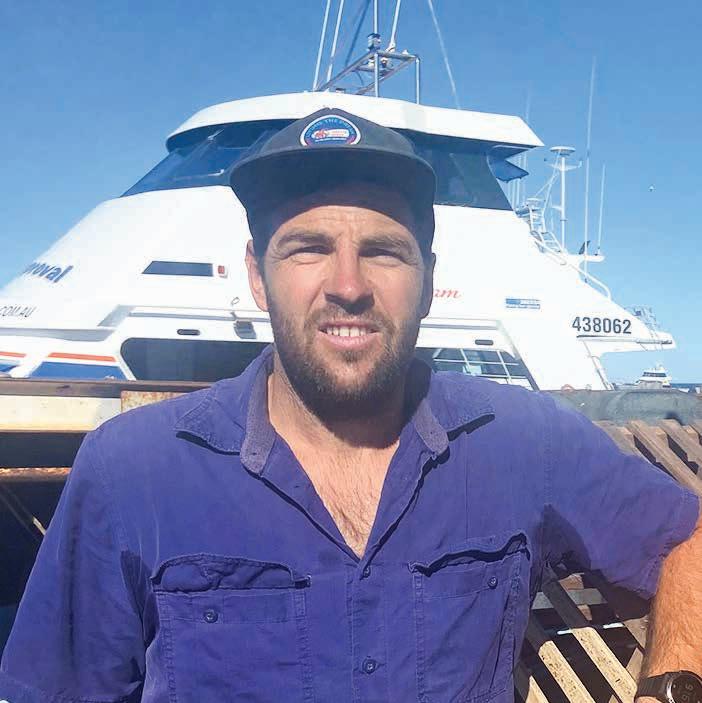
Mat started lobster fishing in 2008, following the family tradition that his grandfather Dave Thompson began in the early 1970s. Mat’s father Matthew and uncles fished and Mat knew it was always going to be his path. But there was a family rule – no lobster fishing until you’ve done a trade. So, Mat completed a trade in Perth then returned to Cervantes to fish, working on deck for five years before skippering one of the family’s nine boats. His fishing grounds are generally around the Cervantes/Jurien Bay area with the occasional stint in Mandurah and Lancelin.
Ian - The rawness of just being out on the ocean, away from everything. And the beauty of it....
...Beautiful sunrises and the sea life – sharks, whale sharks, manta rays. It doesn’t get old.
It’s also the excitement of the catch. I always loved fishing as a kid and the excitement of the catch has stayed with me.
What is the most challenging aspect of lobster fishing?
Clay - There are plenty of challenging aspects. There are the financial challenges – to lease quota or not, to fish at the beach price of the

Ian Ralph is a third-generation lobster fisherman who started in the industry when he was 16, following in the footsteps of his father Charlie and his farmer-turned-fisherman grandfather Allan. Ian loved the land but the pull to the water and fishing was too great. But it wasn’t just handed to him on a silver platter. Ian’s dad made him get his own job. Once Ian had worked for someone else for a while and got his skipper’s ticket, his dad was then happy to hand over the reins. Ian’s 17-yearold son now works weekends and school holidays in the business. Based in Kalbarri, Ian’s fishing grounds stretch north to Dirk Hartog Island and south to Dongara.
day or not… Then there are plenty of other things as well – environmental challenges, to work or not in the conditions that the day brings. At the end of the day safety always has to be first and foremost.
Mat - Probably working the rough weather days and keeping your crew safe on the days when it’s not very nice. Mother nature will show you who’s boss with some big waves. You can’t ever take it for granted. You’ve got to keep your wits about you. It’s certainly not as easy as working on flat ground that doesn’t move.
Ian - With the 12-month season now, the biggest challenge is when to fish. With the price changing all the time, you don’t know if it’s a good time to catch or not. You’re always
KALBARRI
second guessing yourself – should you save some of your quota? Price can change day to day. You might have caught all your quota but then the price might be $10 or $20 more than what you caught it at. New rules and regulations are also a challenge. Also, renewable energy and the proposed wind farms out in the ocean, taking up valuable fishing ground with no-go zones.
What’s the longest you’ve been at sea?
Clay - We are only generally at sea for one or two nights at a time, as the produce needs to be landed in prime condition. Although at times we may be working away from our home port for several weeks continuously, we know it’s for a short period and we understand that it’s just what we have to do at that time.
Mat - We’ve always done day trips. Shorter or longer days depending on where we’re fishing, but typically eight to 10-hour days. We try and spread our fishing out over the whole year, taking a couple of weeks off to do boat maintenance and other jobs. We keep it pretty steady.
Ian - Our main trips are two nights, three days, which helps cut the costs with fuel. We typically fish within a 70-mile radius, but sometimes we could be up to about 80 miles offshore. And sometimes only 500 metres from the river mouth.
What do you eat when you’re at sea?
Clay - Generally, on our vessel we all bring our own prepared meals. It’s quick and easy to heat something up rather than cook from scratch when you are getting tossed around out at sea.
Ian - I’ve got a bit of land with a few sheep, so we usually eat a few roasts, chops and stews. Whatever we catch in the pots is fair game so if we’re lucky we might eat a bit of fish or octopus. Cooking a good feed fills up a bit of the time out at sea. I’m the main chef. The boys do all the hard lifting, so I try and do the cooking and look after them
Can you tell us about a particularly memorable or exciting day out on the water?
Clay - I think for any lobster fisher, filling up the boat in a day is always exciting, so those big days are always memorable.
Mat - The most memorable is the first day I went out working with my dad. It was the start of my fishing career which I always wanted to do.
Ian - Just recently I had my son and dad on board, and we filled the boat [with crays]. Three generations out there together having a successful day. I was really proud.
What’s the scariest moment you’ve experienced at sea?
Clay - I probably don’t have a single scariest moment. There have been a few over the years, working with the conditions and unpredicted swells (although the forecasting is far better these days) and it’s always a challenge going in passages and areas that you are not familiar with.
Mat - The scariest times that I’ve experienced at sea have been in...
...lightning storms. You feel very exposed with nowhere to hide. It feels like you’re a floating target!
Ian - Hitting the bottom, putting a hole in the boat and taking on water, about 30 miles from town. We put a crack in the keel and managed to get back to Kalbarri. It was back before quota, so we welded it up and were back fishing the next day. Another scary moment was when a cargo ship just about ran into us one night when we were on anchor… Copping breakers over the bow. All sorts of scary stuff. You used to risk quite a bit years ago when you could catch as much as you could. Now with quotas it’s definitely safer. You’re not risking life and limb to catch a cray.
What would surprise people most about lobster fishing?
Clay - There are probably a few things, like how every single lobster we land is individually checked for size, sex and breeding status (setose, tar, spawn) and then also checked to make sure it meets premium conditions (physically strong, hard shell, no more than two legs missing off one side, feelers are intact etc). It’s definitely time consuming. Another thing that a lot of people are unaware of is that Western rock lobster don’t like dried salt, it makes them flick off all their legs and feelers, so we constantly make sure there isn’t salt drying out on any surface that they are touching.
Mat - Maybe the size of the fishery. The fishery covers from Augusta in the south all the way to Denham in the north.
Ian - A lot of people assume all crayfishers are rich and greedy but most of us are pretty humble and enjoy what we’re doing and would be doing it even if we weren’t making good money, which for a long time we weren’t. It’s about lifestyle. The money is a bonus.
What’s the biggest change you’ve seen in the industry?
Clay - Without a doubt the change from input controls to output, basically the change from a seasonal fishery to a quota fishery. It changed the fishery in so many ways. It’s leaving a lot more lobster on the ground, meaning improved catch rates when we are fishing, and better sustainability. I also believe it gives a better work life balance and is better for families and relationships.
Mat - The change to the quota system. Before that we could catch as much as we could over the season. The harder you worked, the more kilos you’d put over the scales, the more money you’d turnover. Now it’s quota based, which is more lifestyle and family friendly. I do miss the old days. It used to be a lot of fun. I’d go to work, get home, carry on with the boys… But times have changed. I’m a skipper, I have a family. The beauty of the quota is that everyone’s fishing style is different. And the quota is certainly better for the sustainability of the animal. Since going to quota, we’ve seen more biomass on the ground and catch rates have gone up, which has made things more economical.
What is the most unusual thing you have pulled up?
A hairy lobster, covered in coarse hair and with a pair of crab-like pincers.
Clay - It looks like a cross between a lobster, prawn and scampi. In 2010 I pulled up WA’s first known live specimen and it caused quite a flurry of excitement in fishing circles.
Mat - Fish from the depths, so weird that we don’t even know what type of fish they are.
Ian - Half a dozen full stubbies. I don’t know what happened there. They had to go in the ice box for a bit but they were good.
This laksa is like a little piece of Southeast Asia in a bowl, with a truly West Australian twist. We have worked in our flavoursome western rock lobster, the flesh of which lends itself beautifully to a spicy dish. No part of the lobster is wasted here, with the base stock making use of the lobster heads.
• 2 western rock lobster, raw
Quick Lobster Stock (see recipe page 4)
• 1L chicken or vegetable stock
• Heads from 2 western rock lobster (as listed above)
Laksa Broth
• 1 jar (240g) laksa paste (or to taste)
• ¼ cup vegetable oil
• 1L lobster stock (as above)
• 2 Tbsp fish sauce
• 2½ tsp caster sugar
• 4 kaffir lime leaves, bruised
• 400g can coconut milk
• 600g skinless salmon, diced into 3cm pieces
• 1 bunch baby bok choy, trimmed and coarsely chopped
To Serve
• 200g vermicelli noodles, prepared to package instructions
• 1 handful Vietnamese mint, leaves picked
• 2 Lebanese cucumber, quartered lengthways
• 1 cup bean sprouts
• 1 lime, quartered
• Crispy shallots
TO PREPARE
Lobster Stock (see recipe page 4)
Laksa Broth
1. For the laksa, heat the oil in a large heavy-based saucepan over medium-high heat. Add the laksa paste and cook, stirring frequently, for 4 - 5 minutes until paste becomes fragrant and the oil splits.
2. Add coconut milk and cook, stirring, for a further 2 minutes.
3. Add the lobster stock, fish sauce, caster sugar and kaffir lime
leaves. Bring to the boil, stirring, then lower to a simmer for 10 minutes.
4. Meanwhile, heat a small fry pan over high heat. Cook salmon pieces for 1 - 2 minutes each side or until golden and set aside.
5. To the laksa, add the lobster tail pieces, then cook for a further 3 - 4 minutes, until lobster meat is opaque and cooked through.
6. To serve, divide vermicelli noodles and salmon among four bowls. Add lobster and bok choy evenly, then ladle in laksa, top with mint leaves, cucumber and bean sprouts.
7. Scatter over crispy shallots and serve with lime wedges.

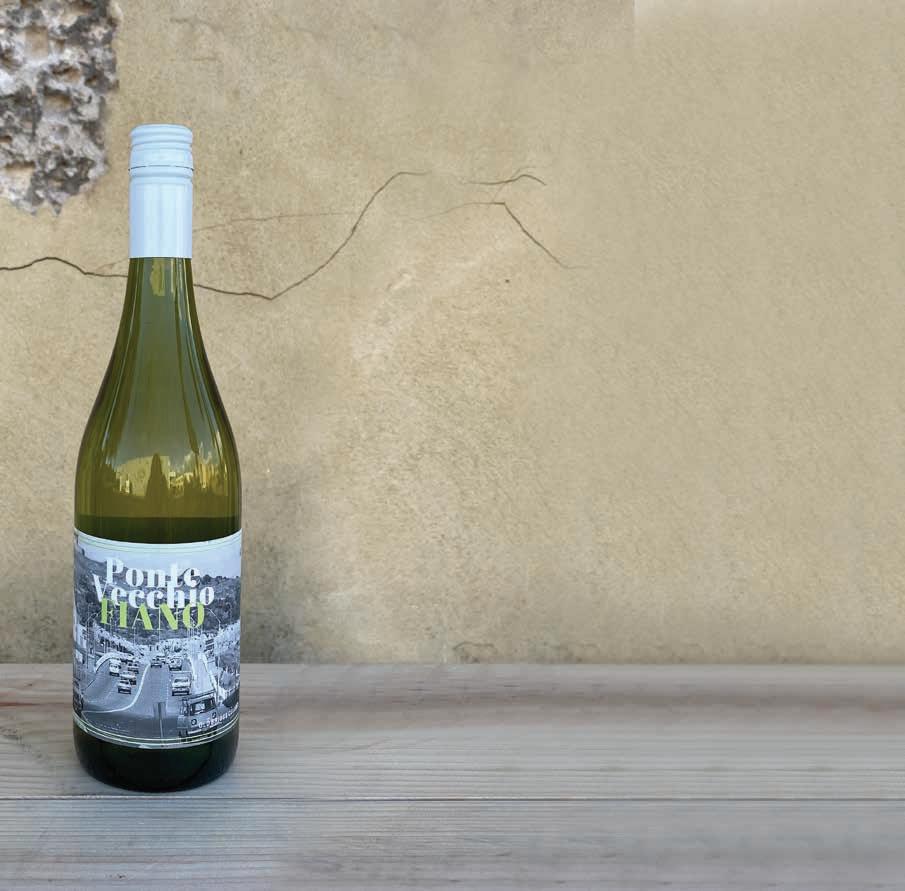
By Jay Beeson of Old Bridge Cellars oldbridge.com.au
Ponte Vecchio Fiano 2023
Makers - Collaboration between Juniper Estate and OBC
This aromatic and textural masterpiece is one of the last wines crafted by Mark Messenger from Juniper Estate before his retirement last year. With enough acidity to balance out the rich laksa flavours, this wine also has the complex aromatics to make this dish sing.

GF option - Use vermicelli noodles made from buckwheat or rice flour.
*Tomalley is the soft, yellow ‘mustard’ found in the head of lobsters.

Lobster
• 2 western rock lobster, raw
• 2 Tbsp plain flour
• 1 Tbsp cornflour
• ½ tsp white pepper
• ½ tsp salt
• 2 cups vegetable oil (for flash deep frying)
Stir Fry
• 2 Tbsp vegetable oil
• 3cm knob ginger, sliced thinly
• 4 spring onions, sliced into 3cm lengths
• 3 Tbsp Shaoxing wine
• 2 Tbsp soy sauce
• 1 tsp toasted sesame oil
• ½ tsp sugar
• ½ tsp ground white pepper
• 1 bunch bok choy, trimmed and quartered lengthwise
To Serve
• Cooked rice
• 1 red chilli, sliced, to serve
TO PREPARE
Lobster Flash-Fry
1. Remove and discard the head of the lobster. Rinse the neck meat gently under running water, rincing away any *tomalley and pat dry with paper towel.
2. Split lobsters in half lengthways, using scissors to snip through the soft underside, then finish with a sharp knife to slice through the flesh and harder outer shell. Remove digestive tract and cut each half into three equal-sized pieces, leaving the shell in place.
3. Gently pat each piece dry with paper towel.
4. In a shallow bowl, mix the plain flour, cornflour pepper and salt. Lightly dust the lobster pieces across the exposed meat to seal in the juices.
5. Heat 2 cups of vegetable oil in a wok to about 180 degrees celsius, (see cook’s notes), slide the lobster into the pot a few pieces at a time and cook for 40 seconds then remove to a plate lined with paper towel to drain. Repeat using all lobster pieces and cover them lightly to keep warm.
Stir Fry
6. Remove old oil from the wok and start with a clean wok over high heat.
7. Add 2 tablespoons of oil, ginger and spring onions to the wok and fry for about 30 seconds, until fragrant.
8. Add the wine and cook for about 2 minutes, infusing the ginger and onion flavours.
9. Add the soy sauce, sesame oil, sugar, white pepper and bok choy. Stir fry for another minute or until the greens are wilted. If required, add a couple of teaspoons of water to the wok to create more sauce, then add the lobster back into the wok, toss quickly then serve with steamed rice.

By Jay Beeson of Old Bridge Cellars oldbridge.com.au
Gewürztraminer Riesling Blend 2023
Makers - Chalari Aromatikós
Aromatikós’ nose oozes perfumed rosewater, saffron and yuzu lemon while the palate has a rounded and textural mouthfeel with well-balanced acidity and hints of sweet lychee and saline adding further complexity.
Cantonese chefs prioritise maintaining the natural flavours and freshness of their ingredients, and what better way to cook western rock lobster than by highlighting the sweet taste of this delicate meat.

GF option - Use gluten free soy sauce and replace plain flour with rice flour.
To test if your oil is hot enough for frying, pop the handle of a wooden spoon or a chopstick in and if it starts steadily bubbling, it’s hot enough for frying.
*Tomalley is the soft, yellow ‘mustard’ found in the head of lobsters.
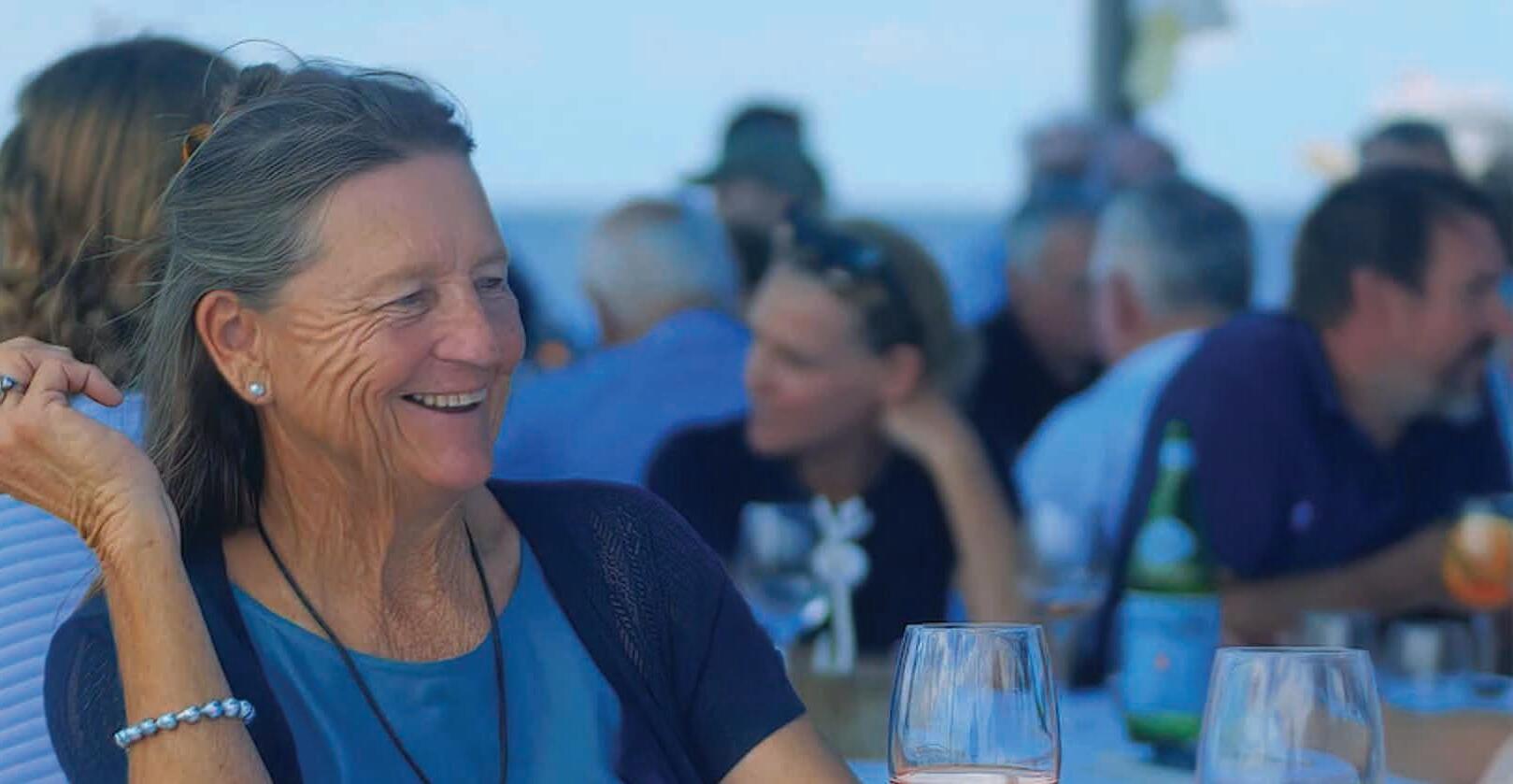
“Seeingwhalescloseup.Theycome outofthewaterjustoffthebackofthe reef.Whenit’scalmyoucanhearthem breathing…
“Feedingfrenzies,withwhalestakingbig scoopsoffishintheirmouths…Packsof pilotwhaleswithyoungones…
“Goingintotownandhavingflyingfish jumpoutofthewateratthefrontofthe boatandtwodolphinsjumpingoutof thewaterandoneofthemcatchinga flyingfishintheair,rightnexttomeon the bow of the boat.
“IrememberwhenIwasyoungonthe carrier boat – which I used to hate, ittooksuchalongtimetogettothe islands–Iwaslyingonthedeckandtwo orcasjumpedoutofthewaterrightnext to the boat and I saw their bellies. I can rememberitsoclearly.
“It’sthingsinthenaturalworldthatare mostamazingforme,andlivingaspart of it. I come outside and there’s a seal asleeponmycouchwithitsheadon mypillow.”
It’s these experiences and the raw isolation that has kept Jane at the Abrolhos Islands (seasonally) most of her life. But it’s not all glassy ocean and natural beauty. “It’s windy and hard a lot of the time but then when it’s not, it’s amazing,” says Jane, who moved to Western Australia from the United Kingdom when she was five. Her father Sid Liddon and auntie Muriel ‘Moo’ Thomas were catching lobster in Dover and moving boats from Holland to England when an ad in a newspaper caught their attention. Fishermen being asked to move to Australia, in particular the Abrolhos Islands, in return for a house and a boat.
They made the move and, despite false promises, it proved prosperous. Nearly 70 years later, the Liddon roots remain deeply embedded at the Abrolhos and in the lobster fishing industry.
When they arrived, there was no house but there were some little old boats for them to choose from. Sids’s boat-building experience meant he could spot a good hull, so they chose an old clinker-built river boat and sawed off most of the cabin. It was named The Puffin.
They arrived to the 1956 cyclone that smashed Geraldton and blew boats into the main street. Adversity turned into opportunity as Sid quickly made a name for himself as a boat builder –fixing boats that were damaged in the cyclone, then building a boat a year in
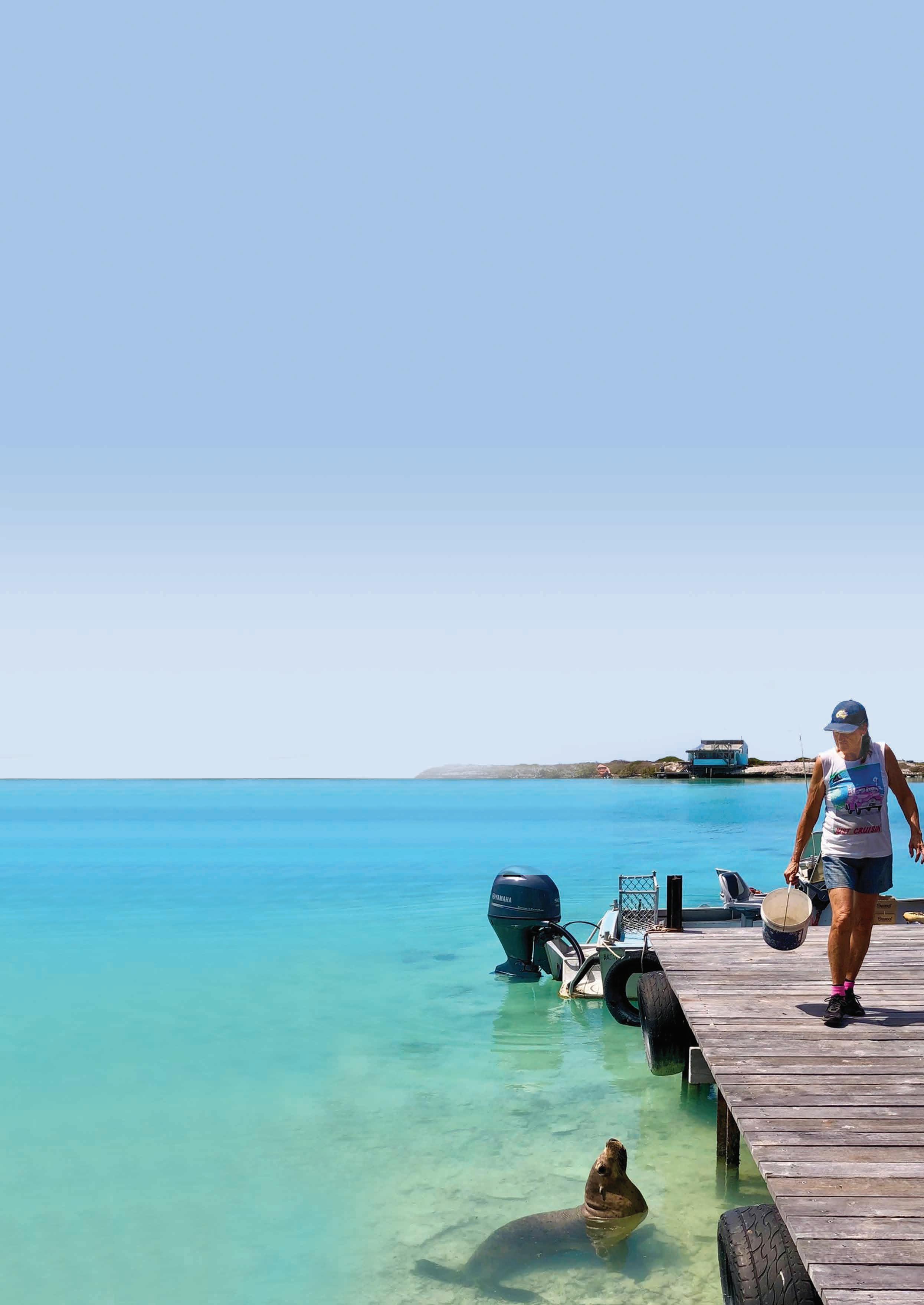
There are so many memorable moments in Jane Liddon’s Abrolhos Islands life that she struggles to single any out. But when pressed, it’s the natural world that she talks about – being part of that natural world.
the off season and, in the late 60s, the first jet boat, unlocking the lobster of the Abrolhos reefs that were inaccessible with a propeller.
After initially living in tiny huts at Wreck Point on Pelsaert Island (locally referred to as Long Island), the family moved to Post Office Island, where Moo built the first shack. This is where the Liddons remain, with Jane’s two sons Sam and Jesse continuing the business and now her grandchildren also becoming involved. The Liddons operate one of the few smaller boats left in the industry. With the change to the quota system in 2010, many of the smaller boats were no longer viable. Where the Liddons used to race against 18 other small boats on the reef to meet the A-zone time limit from 15 March to 30 June, they are now pretty much on their own, deciding when to fish throughout the year and doing it at a much slower and safer pace.
Jane started helping out as a deckhand from when she was about 13, “helping Moo with the ‘whites’ after school finished for the year down the mainland coast at Cliff Head”. It wasn’t necessarily going to be Jane’s career. She went to art school, she travelled, she taught art… But in the early 1980s when she was 30, she returned and started skippering a boat. In Jane’s family, it was normal for females to be in the rock lobster industry. Jane had grown up watching her pioneering aunt skipper a boat. And build a boat. But it wasn’t so normal in the broader industry. Jane says one of the hardest things for females was building up sea time as a deckhand before they could get a skipper’s ticket. She says there are more female skippers around these days, though still not many.
In the2000s, Jane decided that lobster fishing wasn’t enough. The Liddons had all grown up on Post Office Island and loved the seasonal life out there but had to find a way to make it more viable. Pearls and tourism ended up being the answer and in 2006 they harvested their first pearls.
“I wouldn’t say it’s a great success economically unless you value add, which is what we’re doing, making our own jewellery and selling it,” says Jane, grateful to have her daughter-in-law Michela working with her on the pearling side of the business. “And we’ve expanded that into light-touch tourism. Small expedition ships come and do a pearl farm tour and buy our jewellery.”
There’s also the annual long-table lunch Pearls and Plates, held over three days every autumn. It’s a celebration of lobster and other Abrolhos seafood, as well as art, pearls, jewellery and live music. It’s also a celebration of the Liddon family’s Abrolhos lifestyle on Post Office Island, which perhaps would be better named Postcard Island.
“It’s a low-lying island, shaped like a ragged letter C with a lagoon in the middle. Coral, mangroves, a tiny sandy beach on the east side. It’s beautifully peaceful. Everything is based around the lagoon, which we scoot across on dinghies to each other’s shacks. There are a couple of blue holes where we have jetties over the ocean.”
Jane doesn’t like how windy it gets. “But it makes you appreciate it when it’s calm,” she says. “Some people come here and feel exposed because it’s so low-lying and no protection from the wind. But I love the wildness and the isolation. There’s so much sky and a 360-degree horizon. The island is like a sea desert.”
“We are so lucky here in WA to have such amazing seafood right on our doorstep,” says Scott Bridger, co-owner and executive chef at North Fremantle restaurant Bib and Tucker.
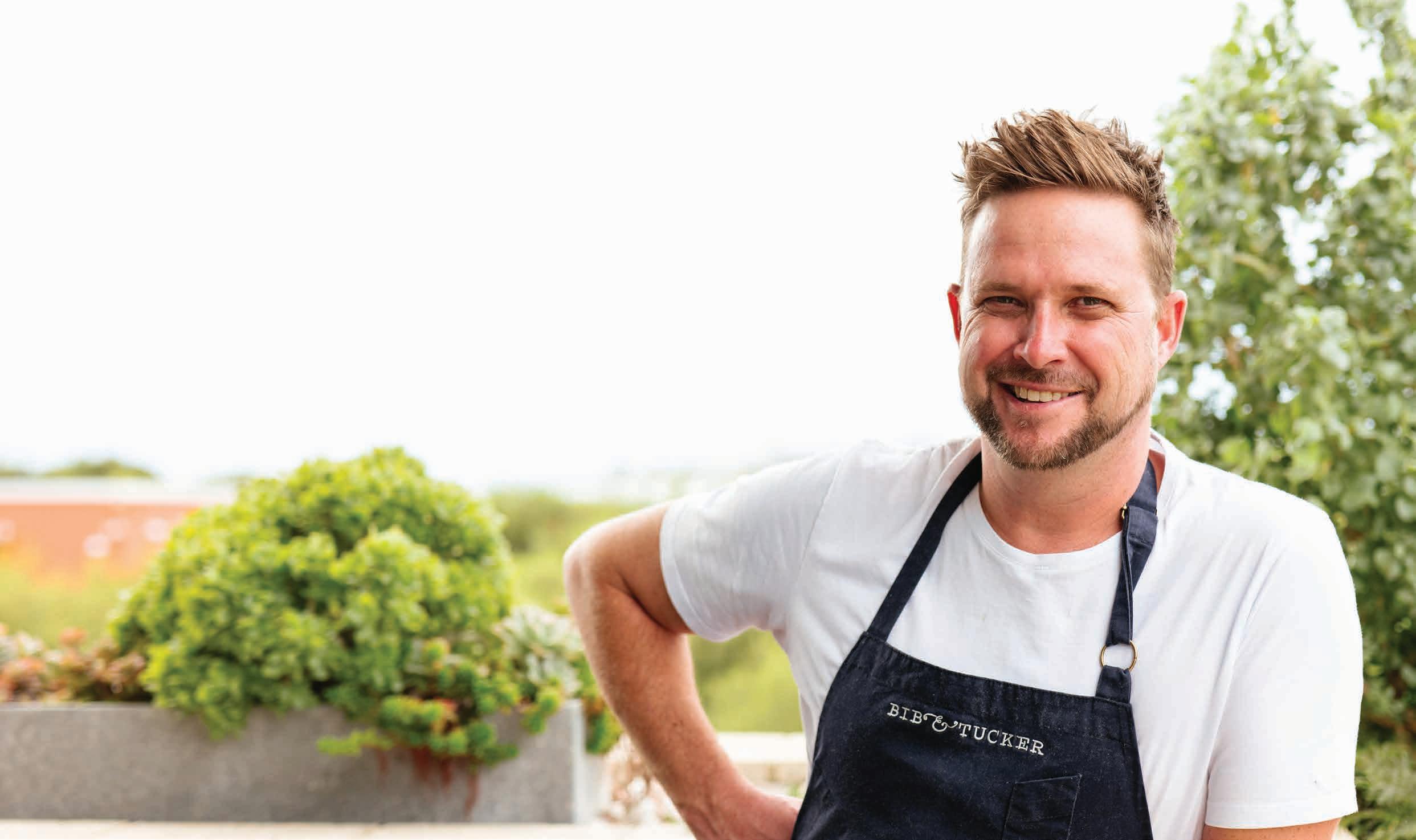
On the doorstep indeed! Delivered live to the restaurant door by the fisherman himself, western rock lobster defines WA freshness and quality of product. For Scott and many others who grew up around the ocean, it also offers a sense of nostalgia. “When I was a kid, we’d catch crays and eat them at home, but you didn’t see them much in restaurants. It’s really nice to see them on menus these days. The public loves it and wants to see more of it.”
In recent years, lobsters have become more affordable locally, making it financially viable for restaurants to put them on their menu. Bib and Tucker goes through 2030kg of lobsters a week and Scott is in constant contact with the local fisherman who delivers them fresh from the water. “I’ve worked all over the world, spent a lot of time in fish markets and it’s definitely very unique to be speaking directly to someone who is catching produce that’s going to be on your menu.”
The product is also pretty unique. “It’s growing and living in one of the cleanest oceans in the world,” says Scott. “Testament to why the rest of the world wants it.”
“It’s growing and living in one of the cleanest oceans in the world. Testament to why the rest of the world wants it.”
It’s also testament to why Scott loves to serve lobster raw. “It’s a beautiful way to eat lobster and how I love to serve it, be it in the restaurant or at home. You get the really clean flavour of the flesh itself. It’s stunning. You’ve just got to be brave enough and have a bit of technique.”
Scott says this can be done as a crudo, just by slicing the raw lobster and adding an acidic element. Recently, he’s enjoyed incorporating Japanese flavours such as seaweed, sesame, white soy and yuzu juice, and diners have been loving it.
Cooking lobster through a wood-fire oven is another favourite of Scott’s. “We put it through at a very high heat then pull it back when it has a bit of colour, a bit like searing meat. Then we add sauces or butter.”
A mainstay on the Bib and Tucker menu is the lobster taco. The lobster is steamed, the flesh taken out and the shells roasted slowly in the pan with oil for three hours, then strained. The lobster-flavoured oil is used to make an emulsion for the meat to be folded into.
“We use a lot of native flavours such as finger limes and lemon myrtle,” says Scott. “That’s the beauty of the cray – it’s so clean. The meat itself is super subtle and fresh, making it a really nice vessel to carry any flavour.”
Lobster frites recently came back on the menu as a mid-week special. Wood-fired lobster served with hand-cut frites and seaweed bearnaise sauce. Selling out each week and with growing wait lists, this is an obvious favourite.
At home, Scott loves to cook lobster spaghetti for his family. He keeps it simple, with lemon, chilli, herbs, a bit of stock (made out of the shells) and cherry tomatoes. His kids love it.
And what about cray for breakfast? “Absolutely! We put a lobster crumpet on the menu at the start of summer, wondering if it would sell. It went nuts.”
Scott’s tip?
“Don’t waste the coral [tomalley] – the yellow ‘mustard’ in the head. It’s really nice to play around with ways of using it. At the very least, I suggest scraping it out and mixing it with butter.”
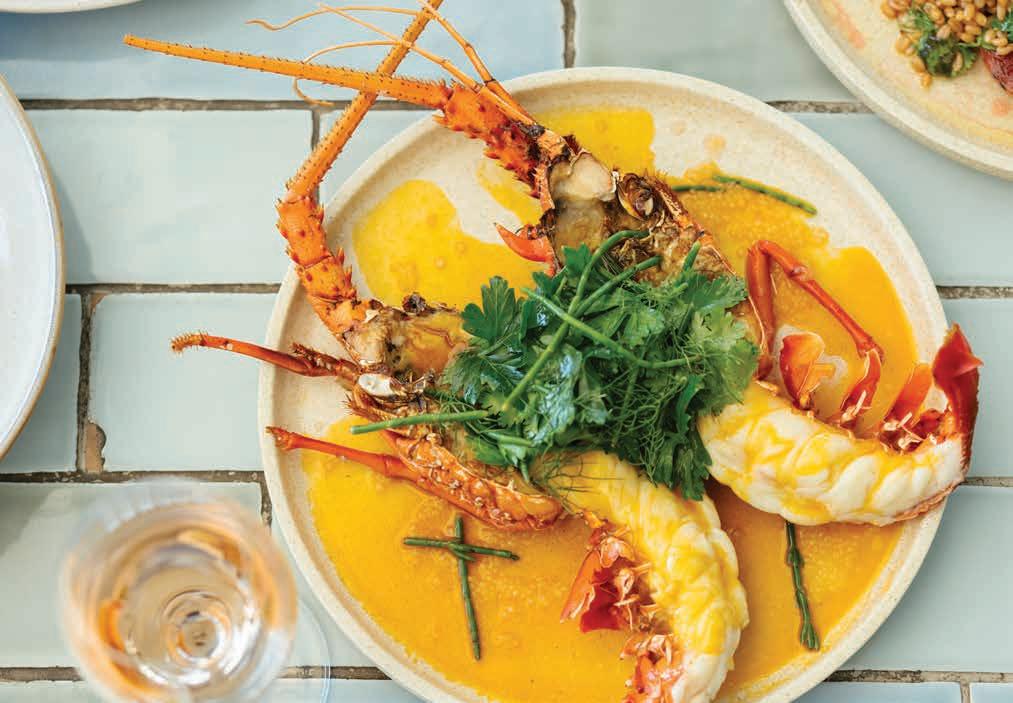


EMILY TAYLOR BAR & KITCHEN
19-29 HENDERSON ST, FREMANTLE
HEAD CHEF: Danny Feng
NAME OF DISH: Lobster & Manjimup Truffle Dumplings
DESCRIPTION OF DISH: Western rock lobster with Manjimup truffle oil, prawn and sweet aromatic soy sauce.

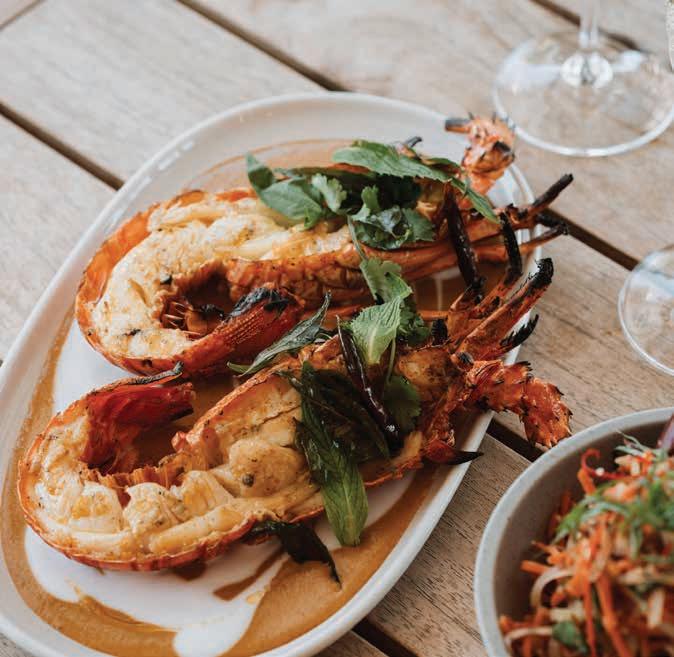
MCCALLUM AVE, ROTTNEST ISLAND
HEAD CHEF: Quim Hernandez
NAME OF DISH: Malaccan Grilled Rock Lobster
DESCRIPTION OF DISH: Cervantes crayfish, curry leaf, black pepper, chilli, spring onion, soy & oyster sauce.

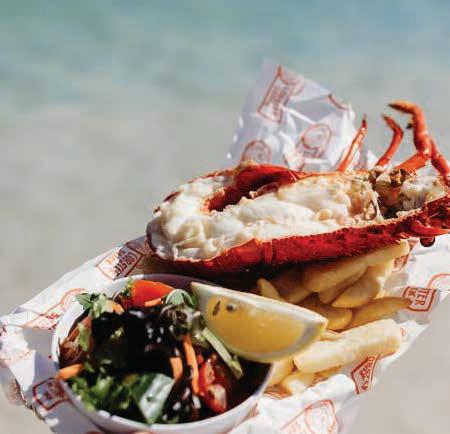
37 CATALONIA ST, CERVANTES
HEAD CHEF: Diego Da Silva
NAME OF DISH: Half Grilled Lobster
DESCRIPTION OF DISH: Grilled western rock lobster cooked in a garlic butter and served with chips and salad.
“We love using the best possible WA seafood in our dumplings, and we love matching with local truffle oils from our great state. Fremantle is a very popular location for tourists, and we love to offer them a dish which presents WA so well.”
“Our dish is as decadent as it is truly local, with sweet-juicy lobster flesh perfectly combined with a gutsy, full-flavoured black pepper sauce. There isn’t anything better than enjoying this dish while taking in the view over the West Coast waters where these lobsters are caught. And to top it off, knowing they are sustainably sourced makes the dish taste even more delicious!”
“As a chef, working with western rock lobster is very special to me. Being part of Cervantes’ crayfishing scene feels like a real privilege—it’s all about history, passion, and respect. And when I’m cooking up those lobsters at the Lobster Shack, I’m serving a slice of that entire experience right onto each plate.”
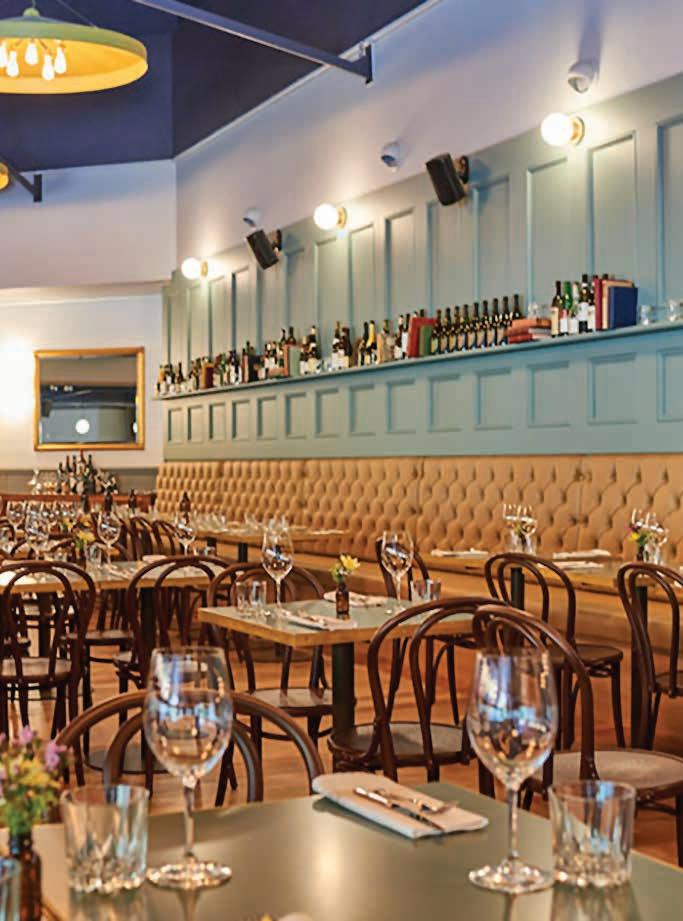

72 OUTRAM STREET, WEST PERTH
HEAD CHEF: Nina Schmedje
NAME OF DISH: Seafood Platter
DESCRIPTION OF DISH: Half crayfish, freshly shucked oysters, clams marinière, Shark Bay tiger prawns, Marie Rose & mignonette.


1 MENDS STREET, SOUTH PERTH (Located in the depth of The Station)
HEAD CHEF: Ludovic Mulot
NAME OF DISH: Lobster Éclair
DESCRIPTION OF DISH: Choux pastry (or pâte à choux as Ludo would say), made in-house with a balance of sweetness that goes perfectly with the lobster; tarragon, celery and Oscietra Black caviar, adding another level of texture and flavour.
FREMANTLE LOBSTER
+61 8 9494 2729
john@fremantlelobster.com.au
48 Barberry Way, Bibra Lake
INDIAN OCEAN ROCK LOBSTER
+61 8 9652 7010
production@iorl.com.au
11 Madrid Street, Cervantes
GERALDTON FISHERMEN’S CO-OPERATIVE
+61 8 9965 9000
sales@brolos.com.au 11 Ocean Street, Geraldton
KB FOOD CO.
+61 8 9455 8500
sales@kbfoodco.com.au
23 Catalano Road, Canning Vale
BLUWAVE
“Western rock lobster is the quintessential taste of Perth, reminiscent of family feasts, sweet, sumptuous but firm and light in texture. Lobster tail can be luxurious and satiating with its rich and buttery undertones.”
“Cooking with western rock lobster is appealing due to its delectable sweetness and ability to enhance a wide range of dishes. Its inclusion on the menu elevates the dining experience, offering patrons a luxurious and flavourful seafood option.”
+61 0408 262 342
sales@bluwave.com.au
22 Mews Road, Fremantle
LOBSTER ALIVE
+61 0418 566 103
piero@lobsteralive.com.au Unit 3, 8 Whipple St, Balcatta
